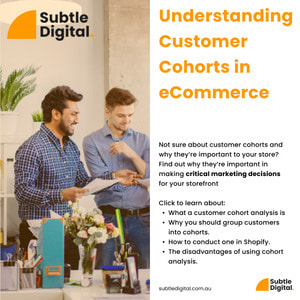Table Of Contents
- 1. What is a customer cohort analysis?
- 2. Why do I need to group customers into cohorts?
- 3. How do you conduct a customer cohort analysis in Shopify?
- 4. How should I group customers into cohorts?
- 5. What are the disadvantages of using cohort analysis?
What is a customer cohort analysis?
A customer cohort analysis is the process of analysing the behaviour of a selected subset of customers. Outcomes from the analysis can include a clearer picture of how and why they engage with your brand.
Why do I need to group customers into cohorts?
When you group customers into cohorts you gain the ability to explain typical behaviour of that cohort that can influence future marketing decisions for your buckets of acquisition or retention strategies.
Analysis could identify the following trends:
- Do customers in November (Black month) purchase less or more than customers from January?
- Do Facebook customers spend more or less over their lifetime?
- Do customers from campaign x add more to cart than y?
How do you conduct a cohort customer analysis in Shopify?
In Shopify you can access the cohort area by heading to analytics > reports > customer cohort analysis.
Depending on the outcome you have the ability to segment by the following metrics:
- Amount spent per customer
- Average order value
- Customer retention rate
- Gross sales
- Net sales
- Number of customers
- Total sales
Include specific inclusions related to channel and product:
- Sales channel
- Marketing channel
- Marketing type
- Product name
- Includes subscription
Finally filter by customer specific metrics such as:
- Country
- Region
- City
- Email subscription status
The chart displayed will outline the cohorts (based on metrics, inclusions and customer filters) broken down by time period (month 1, 2, 3 etc.).
How should I group customers into cohorts?
Each brand will try to answer a different question so this entirely comes down to you and what you’re trying to achieve. I suggest that you start with a question that you’d like to answer before diving in, otherwise you might end up with information paralysis. Here’s a few to start with.
A (non-exhaustive) list:
- Do customers from black month (November) spend more than customers in January? If so, why is this the case?
- Do customers who come from a specific channel (Facebook, Instagram) spend more over time? Do they add more to their basket? If so, what are the typical time periods that they purchase and why?
- How effective is email as a channel in driving repeat purchases overtime? Do our email customers spend more over time? Or do they churn at x period?
- What is the lifetime value of a customer in Sydney vs Melbourne? Does the cohort spend more over time or add more to their basket? Do they purchase different categories?
What are the disadvantages of using cohort analysis?
While the benefits to using a platform like Shopify are great for a quick glance, they only provide a handful of cohort metrics. Two areas to consider are further segmentation and the why behind.
Firstly to get the most out of a cohort analysis, you should be diving into further segmentation breakdown – channel split, campaign performance, product/category segmentation – this will allow you to better understand the direct impacts of your marketing strategy and campaigns across different channels and mediums.
Lastly, the why people do what they do can help you uncover hidden reasons why customers purchased products your products at a certain point in time. This should be conducted through qualitative means such as surveys, focus groups and interviews.


